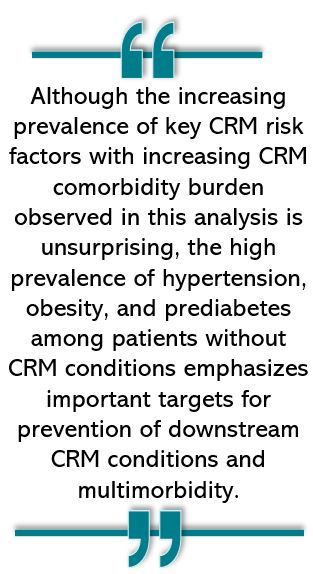One or More Cardiac, Renal, or Metabolic Conditions Affect 25% of US Adults
An analysis of 2 decades of data reflecting trends in the prevalence and overlap of cardiac, renal, and metabolic (CRM) conditions among US adults has found that more than 25% had at least 1 cardiac, renal, or metabolic condition and that by the end of the 20-year study period (1999-2020), 8% of US adults had an overlap of at least 2 conditions, and 1.5% an overlap of all 3, this latter finding a significant increase from 0.7% in 1999.

The findings, published online September 27, in JAMA Cardiology, reveal disparities in comorbidity burden by age, by race/ethnicity, and by socioeconomic status, and confirm current data on undertreatment in all 3 conditions, including among individuals with the highest risk.
“This analysis shows CRM multimorbidity is increasingly prevalent and historically undertreated among US adults, supporting the development of team-based, comprehensive, and equitable management strategies to enable attainment of prevention and treatment goals throughout the life span and across the CRM continuum,” investigators wrote.

The estimated prevalence of the individual CRM conditions among US adults is 9% - 11% for cardiovascular disease (CVD), 15% for chronic kidney disease (CKD) and 13% for diabetes (95% of diabetes being attributed to type 2 diabetes [T2D]), according to research cited in the study. How often the 3 conditions overlap in the adult population has not been “comprehensively characterized,” wrote the researchers. A more detailed understanding of the prevalence of the dangerous overlap, they added, will help inform clinical practice, research, policy development, and design of health care services.
Led by John Ostrominski, MD, of the Brigham and Women’s Hospital Heart and Vascular Center, the research team conducted a cross sectional analysis of data from the National Health and Nutrition Examination Survey (NHANES), using survey cycles from 1999 through 2020.

The investigators’ 2-part approach began with a review of NHANES data from 2015 to 2020 to establish the contemporary prevalence of the 3 CRM conditions. To assess temporal trends in CRM and overlap, the team then compared NHANES data collected between 1999-2002 with data collected between 2015-2020.
The primary outcome measures were the proportion of participants with CRM conditions (CVD, CKD, and T2D, or all 3), for the entire cohort and then stratified by age.
FINDINGS
The analysis of survey cycles between 2015 and 2020 included 11 607 adults aged 20 years or older. The cohort had a mean age of 48.5 years and 51.0% were women. According to the study, participants self-identified as Hispanic (15.3%), non-Hispanic Asian (5.4%), non-Hispanic Black (10.6%), and non-Hispanic White (64.8%); 3.9% reported being of another race or ethnicity or multiracial.
Ostrominski and team reported that 26.3% had at least 1 CRM condition, 8.0% had at least 2 and 1.5% had all 3 CRM conditions. Their analysis found that CKD plus T2D was the most prevalent CRM “dyad” (3.2%) followed by CVD plus T2D (1.7%) and CVD plus CKD (1.6%). Risk factor analysis found that older age and male sex were associated with higher disease burden.

Age. Following stratification of CRM burden by age researchers found that participants aged 65 years and older comprised more than two-thirds (69.0%) of participants with 3 CRM overlap vs 12.4% of those without a CRM condition. In this age group, the prevalence of US adults with 1 CRM condition increased to 33.6%, with 2 conditions prevalence increased to 17.1%, and with 3 CRM conditions, prevalence was 5.0%. Investigators reported that the most common dyad among these older adults was CKD plus T2D (7.3%), followed by CVD plus CKD (6.0%) and CVD plus T2D (3.8%)
Race/ethnicity. Evaluation of characteristics associated with higher CRM comorbidity found the burden disproportionately high among patients reporting non-Hispanic Black race or ethnicity, unemployment, low socioeconomic status, and no high school degree.
Undertreatment. Confirming known low treatment rates for US adults with chronic disease, the researchers reported that among participants with 3 CRM conditions, nearly one-third (30.5%) reported not using statin medications. Use of antidiabetes medications with indications for all 3 chronic conditions was remarkably low, with only 4.8% reporting GLP-1 receptor agonist use, and just 3.0% reporting SGLT2 inhibitor use.
Risk factors. Prevalence of key risk factors for CVD, CKD, and T2D in the full cohort were significant, the investigators noted with concern, with obesity reported in 41.2%, hypertension in 38.5%, hypercholesterolemia in 29.0%, and prediabetes in 25.9%.
Overall, the trend over time in prevalence of CVD, CKD, and T2D conditions pointed to a significant increase in the proportion of US adults with multiple conditions, from 5.3% in 1999 to 8.0% in 2020 (P < .001) and to an equally significant increase in the proportion of those with overlap of all 3 conditions, from 0.7% to 1.5% (P < .001).
“These data reinforce the need to embrace the complexities imposed by concurrent CRM conditions in research efforts, clinical practice, guideline development, and the formulation of public health policy,” investigators wrote in conclusion.








